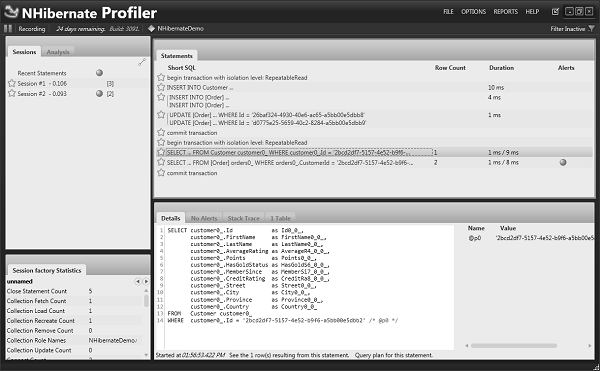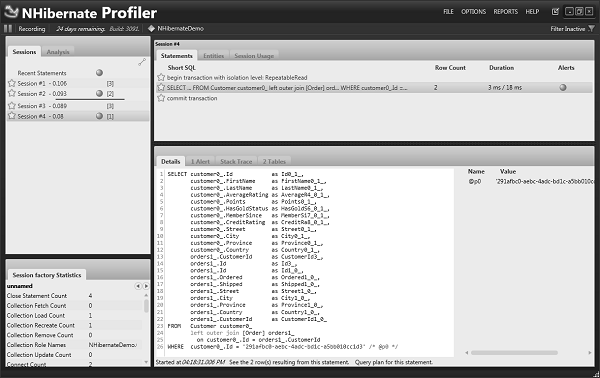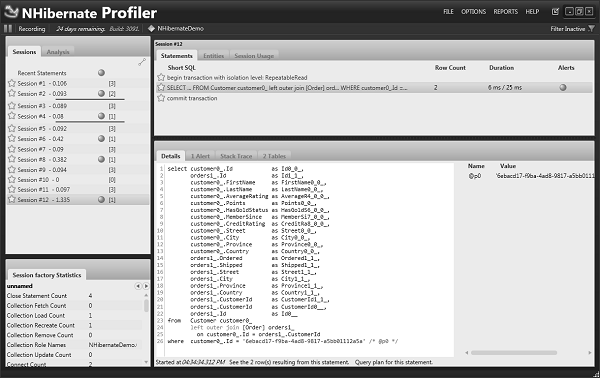
- NHibernate Tutorial
- NHibernate - Home
- NHibernate - Overview
- NHibernate - Architecture
- NHibernate - Orm
- NHibernate - Environment Setup
- NHibernate - Getting Started
- NHibernate - Basic Orm
- NHibernate - Basic Crud Operations
- NHibernate - Profiler
- Add Intelliesnse To Mapping File
- NHibernate - Data Types Mapping
- NHibernate - Configuration
- NHibernate - Override Configuration
- NHibernate - Batch Size
- NHibernate - Caching
- NHibernate - Mapping Component
- NHibernate - Relationships
- NHibernate - Collection Mapping
- NHibernate - Cascades
- NHibernate - Lazy Loading
- NHibernate - Inverse Relationships
- NHibernate - Load/Get
- NHibernate - Linq
- NHibernate - Query Language
- NHibernate - Criteria Queries
- NHibernate - QueryOver Queries
- NHibernate - Native Sql
- NHibernate - Fluent Hibernate
- NHibernate Useful Resources
- NHibernate - Quick Guide
- NHibernate - Useful Resources
- NHibernate - Discussion
NHibernate - Lazy Loading
In this chapter, we will be covering the lazy loading feature. It is an entirely different concept by default and NHibernate doesn't have lazy loading, for example if you load a customer, it's not going to load all of the orders.
The order collection will be loaded on demand.
Any association, whether it be a many-to-one or a collection is lazy loaded by default, it requires an Open ISession.
If you have closed your session, or if you have committed your transaction, you can get a lazy load exception that it cannot pull in those additional objects.
You have to be careful about lazy loading and how much data you actually need.
You can turn off lazy loading for an entire association or you could put lazy equals false or you can also specify a fetching strategy.
Here is the Program.cs file implementation.
using System;
using System.Data;
using System.Linq;
using System.Reflection;
using HibernatingRhinos.Profiler.Appender.NHibernate;
using NHibernate.Cfg;
using NHibernate.Dialect;
using NHibernate.Driver;
using NHibernate.Linq;
namespace NHibernateDemo {
internal class Program {
private static void Main() {
var cfg = ConfigureNHibernate();
var sessionFactory = cfg.BuildSessionFactory();
Guid id;
using(var session = sessionFactory.OpenSession())
using(var tx = session.BeginTransaction()) {
var newCustomer = CreateCustomer();
Console.WriteLine("New Customer:");
Console.WriteLine(newCustomer);
session.Save(newCustomer);
id = newCustomer.Id;
tx.Commit();
}
using(var session = sessionFactory.OpenSession())
using(var tx = session.BeginTransaction()) {
var reloaded = session.Load<Customer>(id);
Console.WriteLine("Reloaded:");
Console.WriteLine(reloaded);
Console.WriteLine("The orders were ordered by: ");
foreach (var order in reloaded.Orders) {
Console.WriteLine(order.Customer);
}
tx.Commit();
}
Console.WriteLine("Press <ENTER> to exit...");
Console.ReadLine();
}
private static Customer CreateCustomer() {
var customer = new Customer {
FirstName = "John",
LastName = "Doe",
Points =100,
HasGoldStatus = true,
MemberSince = new DateTime(2012, 1, 1),
CreditRating = CustomerCreditRating.Good,
AverageRating = 42.42424242,
Address = CreateLocation()
};
var order1 = new Order { Ordered = DateTime.Now };
customer.AddOrder(order1);
var order2 = new Order {
Ordered = DateTime.Now.AddDays(-1),
Shipped = DateTime.Now,
ShipTo = CreateLocation()
};
customer.AddOrder(order2); return customer;
}
private static Location CreateLocation() {
return new Location {
Street = "123 Somewhere Avenue",
City = "Nowhere",
Province = "Alberta",
Country = "Canada"
};
}
private static Configuration ConfigureNHibernate() {
NHibernateProfiler.Initialize();
var cfg = new Configuration();
cfg.DataBaseIntegration(x => {
x.ConnectionStringName = "default";
x.Driver<SqlClientDriver>();
x.Dialect<MsSql2008Dialect<();
x.IsolationLevel = IsolationLevel.RepeatableRead;
x.Timeout = 10;
x.BatchSize = 10;
});
cfg.SessionFactory().GenerateStatistics();
cfg.AddAssembly(Assembly.GetExecutingAssembly());
return cfg;
}
}
}
To understand this, let's run the application and take a look at the NHibernate Profiler.

As you can see that we have the Select From Customer, given a particular customer ID and then we also have another Select From Orders table, when it actually accesses that customer's collection.
So we have 2 roundtrips to the database. Now, sometimes, we would want to optimize this. To do this, let’s go to the customer.hbm.xml file and add a fetching strategy and ask it to do a join fetch.
<?xml version = "1.0" encoding = "utf-8" ?>
<hibernate-mapping xmlns = "urn:nhibernate-mapping-2.2" assembly = "NHibernateDemo"
namespace = "NHibernateDemo">
<class name = "Customer">
<id name = "Id">
<generator class = "guid.comb"/>
</id>
<property name = "FirstName"/>
<property name = "LastName"/>
<property name = "AverageRating"/>
<property name = "Points"/>
<property name = "HasGoldStatus"/>
<property name = "MemberSince" type = "UtcDateTime"/>
<property name = "CreditRating" type = "CustomerCreditRatingType"/>
<component name = "Address">
<property name = "Street"/>
<property name = "City"/>
<property name = "Province"/>
<property name = "Country"/>
</component>
<set name = "Orders" table = "`Order`" cascade = "all-delete-orphan"
fetch = "join">
<key column = "CustomerId"/>
<one-to-many class = "Order"/>
</set>
</class>
</hibernate-mapping>
As you can see that we haven't changed any code in our application, we have just added a fetching strategy in the customer.hbm.xml. Let’s run this application again, it still behaves exactly the same way. Let's look at NHibernate Profiler.

Before, program had two round trips to the database, now, it only has one and that's because it's doing a left outer join here.
We can see that it's doing a left outer join between the customer table and the order table based on the customer ID, and therefore, it's able to load in all of that information at once.
We have saved 1 roundtrip to the database.
The down side is that the customer information will be duplicated on both lines and that's the way that a SQL left outer join works.
So with the fetching strategy, we are pulling back a bit more data and we are saving a roundtrip.
You can also do this at the query level, so let's go to the Program.cs file and look at the simpler reloaded example.
using(var session = sessionFactory.OpenSession())
using(var tx = session.BeginTransaction()) {
//var query = from customer in session.Query<Customer>()
// select customer;
//var reloaded = query.Fetch(x => x.Orders).ToList();
var reloaded = session.Load<Customer>(id);
Console.WriteLine("Reloaded:");
Console.WriteLine(reloaded);
Console.WriteLine("The orders were ordered by: ");
foreach (var order in reloaded.Orders) {
Console.WriteLine(order.Customer);
}
tx.Commit();
}
Here, we are doing a load by the customer. Now let’s change it to a query and we will use a link query as shown in the following code.
using(var session = sessionFactory.OpenSession())
using(var tx = session.BeginTransaction()) {
var query = from customer in session.Query<Customer>()
where customer.Id == id select customer;
var reloaded = query.Fetch(x => x.Orders).ToList().First();
Console.WriteLine("Reloaded:");
Console.WriteLine(reloaded);
tx.Commit();
}
Let’s also remove the fetching strategy from the customer.hbm.xml file.
<?xml version = "1.0" encoding = "utf-8" ?>
<hibernate-mapping xmlns = "urn:nhibernate-mapping-2.2" assembly = "NHibernateDemo"
namespace = "NHibernateDemo">
<class name = "Customer">
<id name = "Id">
<generator class = "guid.comb"/>
</id>
<property name = "FirstName"/>
<property name = "LastName"/>
<property name = "AverageRating"/>
<property name = "Points"/>
<property name = "HasGoldStatus"/>
<property name = "MemberSince" type = "UtcDateTime"/>
<property name = "CreditRating" type = "CustomerCreditRatingType"/>
<component name = "Address">
<property name = "Street"/>
<property name = "City"/>
<property name = "Province"/>
<property name = "Country"/>
</component>
<set name = "Orders" table = "`Order`" cascade = "all-delete-orphan">
<key column = "CustomerId"/>
<one-to-many class = "Order"/>
</set>
</class>
</hibernate-mapping>
Let’s run this application again and you will see the following output.
New Customer:
John Doe (00000000-0000-0000-0000-000000000000)
Points: 100
HasGoldStatus: True
MemberSince: 1/1/2012 12:00:00 AM (Unspecified)
CreditRating: Good
AverageRating: 42.42424242
Orders:
Order Id: 00000000-0000-0000-0000-000000000000
Order Id: 00000000-0000-0000-0000-000000000000
Reloaded:
John Doe (6ebacd17-f9ba-4ad8-9817-a5bb01112a5a)
Points: 100
HasGoldStatus: True
MemberSince: 1/1/2012 12:00:00 AM (Utc)
CreditRating: Good
AverageRating: 42.4242
Orders:
Order Id: 16a6596b-d56e-41c7-9681-a5bb01112a60
Order Id: d41d615b-0f21-4032-81db-a5bb01112a61
Press <ENTER> to exit...
Now let’s look at the NHibernate Profiler, you can see that we've got this eager join fetch happening once again, but this time, it's based on the query.
